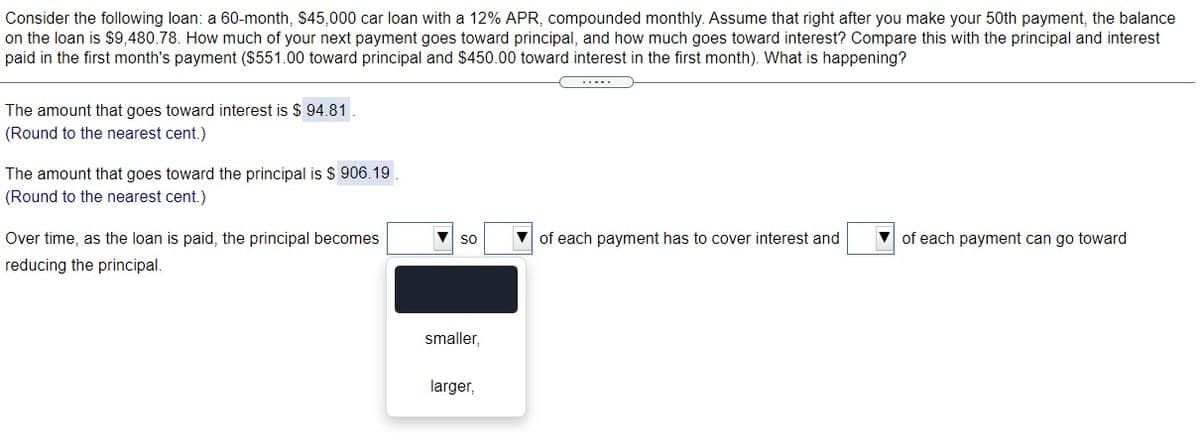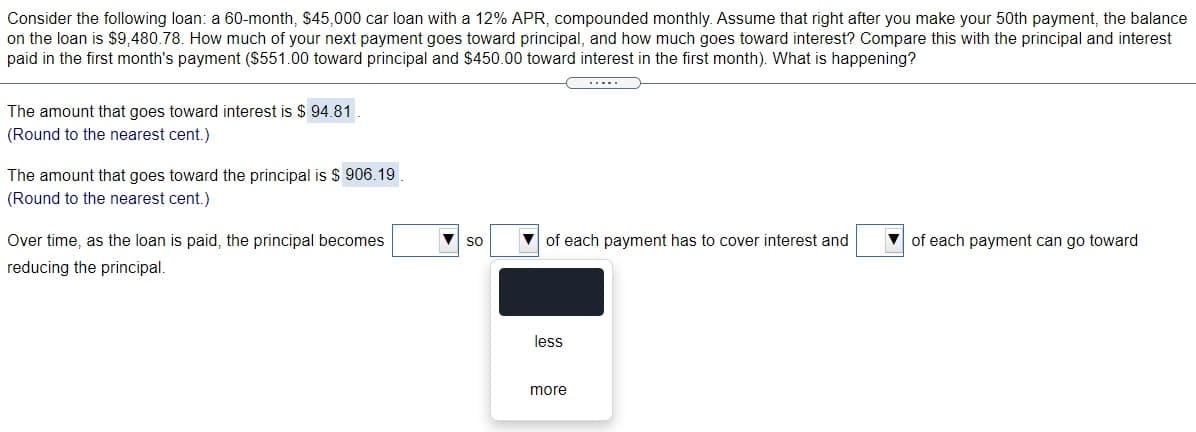Consider the following loan: a 60-month, $45,000 car loan with a 12% APR, compounded monthly. Assume thnat right after you make your 50th payment, the balance on the loan is $9,480.78. How much of your next payment goes toward principal, and how much goes toward interest? Compare this with the principal and interest paid in the first month's payment ($551.00 toward principal and $450.00 toward interest in the first month). What is happening? ..... The amount that goes toward interest is $ 94.81. Round to the nearest cent.) The amount that goes toward the principal is $ 906.19. Round to the nearest cent.) Over time, as the loan is paid, the principal becomes of each payment has to cover interest and V of each payment can go toward so reducing the principal.
Consider the following loan: a 60-month, $45,000 car loan with a 12% APR, compounded monthly. Assume thnat right after you make your 50th payment, the balance on the loan is $9,480.78. How much of your next payment goes toward principal, and how much goes toward interest? Compare this with the principal and interest paid in the first month's payment ($551.00 toward principal and $450.00 toward interest in the first month). What is happening? ..... The amount that goes toward interest is $ 94.81. Round to the nearest cent.) The amount that goes toward the principal is $ 906.19. Round to the nearest cent.) Over time, as the loan is paid, the principal becomes of each payment has to cover interest and V of each payment can go toward so reducing the principal.
Chapter19: Lease And Intermediate-term Financing
Section: Chapter Questions
Problem 17P
Related questions
Question
100%
The third box is also "less or more".

Transcribed Image Text:Consider the following loan: a 60-month, $45,000 car loan with a 12% APR, compounded monthly. Assume that right after you make your 50th payment, the balance
on the loan is $9,480.78. How much of your next payment goes toward principal, and how much goes toward interest? Compare this with the principal and interest
paid in the first month's payment ($551.00 toward principal and $450.00 toward interest in the first month). What is happening?
The amount that goes toward interest is $ 94.81
(Round to the nearest cent.)
The amount that goes toward the principal is $ 906.19
(Round to the nearest cent.)
Over time, as the loan is paid, the principal becomes
V of each payment has to cover interest and
V of each payment can go toward
so
reducing the principal.
smaller,
larger,

Transcribed Image Text:Consider the following loan: a 60-month, $45,000 car loan with a 12% APR, compounded monthly. Assume that right after you make your 50th payment, the balance
on the loan is $9,480.78. How much of your next payment goes toward principal, and how much goes toward interest? Compare this with the principal and interest
paid in the first month's payment ($551.00 toward principal and $450.00 toward interest in the first month). What is happening?
.....
The amount that goes toward interest is $ 94.81 .
(Round to the nearest cent.)
The amount that goes toward the principal is $ 906.19
(Round to the nearest cent.)
Over time, as the loan is paid, the principal becomes
V of each payment has to cover interest and
V of each payment can go toward
so
reducing the principal.
less
more
Expert Solution
This question has been solved!
Explore an expertly crafted, step-by-step solution for a thorough understanding of key concepts.
This is a popular solution!
Trending now
This is a popular solution!
Step by step
Solved in 2 steps with 2 images

Recommended textbooks for you

EBK CONTEMPORARY FINANCIAL MANAGEMENT
Finance
ISBN:
9781337514835
Author:
MOYER
Publisher:
CENGAGE LEARNING - CONSIGNMENT

Intermediate Financial Management (MindTap Course…
Finance
ISBN:
9781337395083
Author:
Eugene F. Brigham, Phillip R. Daves
Publisher:
Cengage Learning

Pfin (with Mindtap, 1 Term Printed Access Card) (…
Finance
ISBN:
9780357033609
Author:
Randall Billingsley, Lawrence J. Gitman, Michael D. Joehnk
Publisher:
Cengage Learning

EBK CONTEMPORARY FINANCIAL MANAGEMENT
Finance
ISBN:
9781337514835
Author:
MOYER
Publisher:
CENGAGE LEARNING - CONSIGNMENT

Intermediate Financial Management (MindTap Course…
Finance
ISBN:
9781337395083
Author:
Eugene F. Brigham, Phillip R. Daves
Publisher:
Cengage Learning

Pfin (with Mindtap, 1 Term Printed Access Card) (…
Finance
ISBN:
9780357033609
Author:
Randall Billingsley, Lawrence J. Gitman, Michael D. Joehnk
Publisher:
Cengage Learning



Principles of Accounting Volume 1
Accounting
ISBN:
9781947172685
Author:
OpenStax
Publisher:
OpenStax College